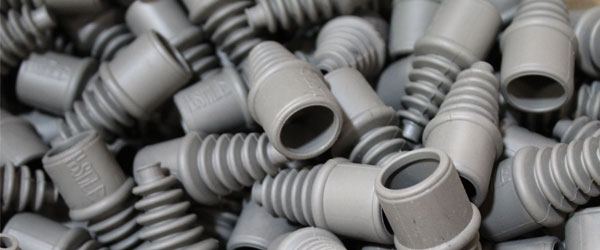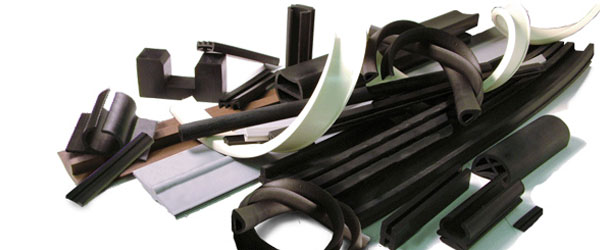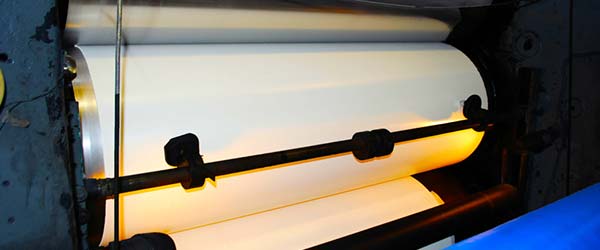Custom Rubber Mixing: Compound Development
Tel: (909) 758-4715 | Email: custserv@goodyearrubber.com
Custom Rubber Mixing: Compounds:
- Fill Factor – approx. 75% of 70 liters (F80 4wing ST rotors free volume)
- Ram seating time (after filler addition) can be used to determine.
- Rule of thumb is 35-45 seconds
- Ram should be “dancing” in its’ end position at the end of the cycle. This phase should be at least 30 seconds long.
- Without Ram seated, there is no dispersion
- Should use Rotor Speed to change temperature during mixing. Wall temperature should be as high as possible for quicker ‘drag in’, faster carbon-black incorporation and highest possible power input during first phase of mixing polymer and fillers
- Process Parameter Considerations
- Start Up – Mixer temperature for constant Mixing Times
- Surface conditions (Slip – Stick) are influenced by contact temperature
- Heat up Mixer Walls to “quasi-stationary” temperature before first batch
- Use cleaning batches to heat up the mixer
- Can take up to 15 batches before “normal” temperature reached
- Ram Pressure is a decisive process parameter
- Without hydraulics, tough to manage
- Start Up – Mixer temperature for constant Mixing Times
- Oil Injection / Addition
- Delayed can achieve better dispersion but it is absolutely necessary to choose a time to inject oil so that enough carbon black surfaces remain available for oil absorption. If not, Lubrification Films are created in the mixer and it becomes difficult to bring energy into the compound.
- Difficult to manually manage but timing is crucial
- “Drowning” the process – If too much oil is injected at once, mixing time can take 30 minutes
- Automated Oil Dosing – Injection is stopped when the power of the machine decreases to a critical level and activated only when certain minimal values for torque are exceeded.
- Reproducible process
- Mixing time reduced to 8.5 minutes
- Development of a Mixing Cycle – Custom Rubber Mixing Process
- Determine Fill Factor
- If ram is late (or doesn’t close) then batch weight must be reduced
- To calculate respective value: cross section area of chute multiplied by ‘ram setback’ position = volume to subtract
- Determine “Masterbatch Rotor Speed”
- Set with regard to temperature development
- Typically incorporation will take 2 – 2.5 minutes
- At Polymer Drag In – Optimum speed for fastest input
- If too high, polymer lumps “dance” on the rotor surfaces
- Also, power peak directly after the addition of the filler to the polymer should be as high as possible to achieve good dispersion
- Determine Fill Factor
*For different phases within the Masterbatch processes, different speeds are necessary: Dragging In, carbon black dispersion, time after power peak
- Analyze “Final Mixing”
- Rotor Speed is optimum: Equilibrium of power input and heat flow via surfaces
- Mixing times can be increased without temperature problem but often a compromise has to be found as “equilibrium speeds” are too low
- If Low Speeds are chosen, the total (ram down) revolutions should be monitored
- More distributive than dispersive, Needs 45-60 seconds to distribute chemicals correctly
- Take into account downstream equipment
- 1 or more mills introduce some mixing energy
- General Issues to consider:
- “Conventional Mixing”: First dosing Polymers, then feeding of the fillers
- Pre-mastication can be achieved; is necessary with Natural Rubber
- Different Polymers – “phase-transition” must be considered
- Fillers have a preference for specific polymer incorporation. In such cases, “pre-mastication” is helpful
- Fillers should only be fed after polymers have formed an interphase system with only small domains of the different partners.
- Disadvantage of conventional mixing
- Polymer temperature already elevated as filler is added
- Additional Ram lift necessary if compressed air blows filler to top of Ram
- Late filler addition can lead to poor dispersion
- >= 2 feeding steps needed
- Chute Contamination possible
- Can Consider Upside Down Mixing
- Not covered now
- “Conventional Mixing”: First dosing Polymers, then feeding of the fillers
 (909) 987-1774
(909) 987-1774 Email Us
Email Us






